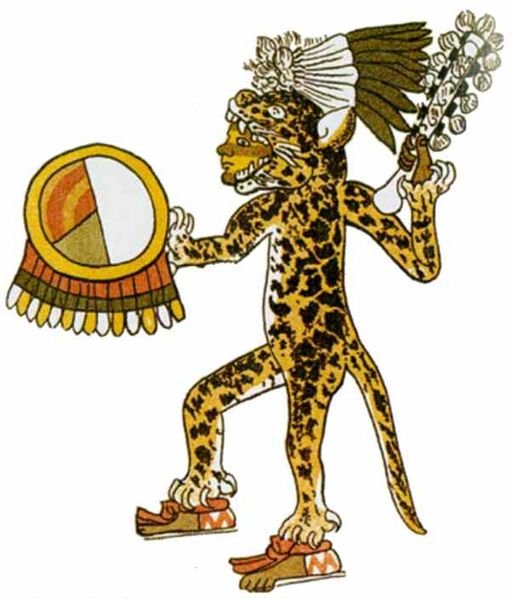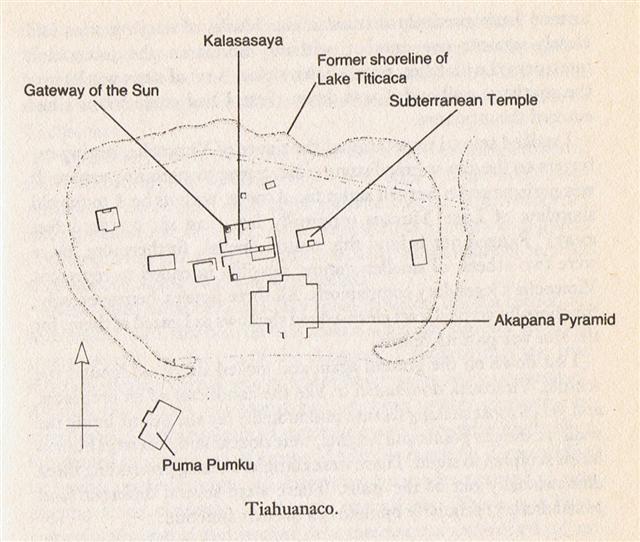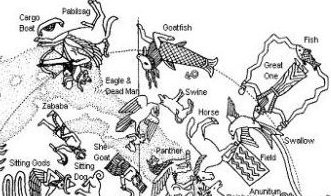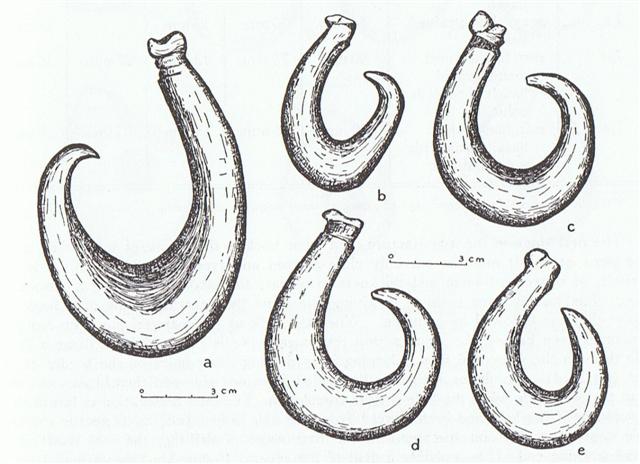It seems reasonable to assume the agricultural revolution changed the mythological framework all over the world, and it evidently had to be based on the mysterious key event of how the burial of a part of the previous 'person' was necessary in order to receive a multitude of offspring ('multiplication'). ... According to an etiological Hawaiian myth, the breadfruit originated from the sacrifice of the war god Kū. After deciding to live secretly among mortals as a farmer, Ku married and had children. He and his family lived happily until a famine seized their island. When he could no longer bear to watch his children suffer, Ku told his wife that he could deliver them from starvation, but to do so he would have to leave them. Reluctantly, she agreed, and at her word, Ku descended into the ground right where he had stood until only the top of his head was visible. His family waited around the spot he had last been day and night, watering it with their tears until suddenly a small green shoot appeared where Ku had stood. Quickly, the shoot grew into a tall and leafy tree that was laden with heavy breadfruits that Ku's family and neighbors gratefully ate, joyfully saved from starvation ...
Kava. 1. Sour; salty: vai kava, saltwater, sea; te kava o te haíga, acrid underarm smell; tagata kava - tagata kakara i te kava, man with smelly armpits. 2. He-kava te haha, to be thirsty. 3. To turn sour, to become embittered, bad-tempered, exasperated (used with manava): tagata manava kava, bad-tempered, angry man. Vanaga. Bitter, salt; vai kava, brackish water; hakakava, to embalm; kavakava, acid, sharp, bitter, salt, spiritous, vinegar, poisonous, disagreeable; akavakava, to make sharp; hakakavakava, to make acid. P Pau.: kava, disagreeable to the taste; kavakava, acid, sharp. Mgv.: kava, to be bitter, sour, acid, salt. Mq.: kava, bitter. Ta.: ava, bitter, acid, salt. Kavahia: 1. Comfort, comfortable, to feast; hakakavahia, comfort, comfortable. 2. Repulsive (of food), disgusted; hakakavahia, repulsion. Kavakava, rib; moi kavakava, a house god G. P Mgv.: vakavaka, the breast. Mq.: vakavaka, vaávaá, rib. Ma.: wakawaka, parallel ridges. We shall need all the available material in order to determine the germ sense of this word. Sa.: va'ava'a, the breast-bone of a bird; fa'ava'a, the frame as of a slate. To.: vakavaka, the side. Fu.: vakavaka, the side below the armpit. Ha.: hoowaa, to make furrows. In all these we may see the idea of ridge or depression, or of both, as primal (Rapanui, Samoa, Marquesas, Maori, Hawaii), and as secondary the part of the body where such appearances is common (Mangareva, Tonga, Futuna). Churchill. Mgv.: kava, the pepper plant and the drink made therefrom. Ta.: ava, id. Mq.: kava, id. Sa.: 'ava, id. Ma.: kawa, a pepper. Kavakava, a fish. Sa.: 'ava'ava, id. Kavapui, a tree. Ta.: avapuhi, a fragrant plant. Mq.: kavapui, wild ginger. Sa.: 'avapui, id. Ha.: awapuhi, id. Churchill. Mq.: ava, a small fish of sweet water. Sa.. 'ava'ava, a small fish. Ha.: awa, a fish. Kakava, burnt. Sa.: 'a'ava, very hot. Churchill. Atua. 1. Lord, God: te Atua ko Makemake, lord Makemake. Ki a au te Atua o agapó, I had a dream of good omen last night (lit. to me the Lord last night). 2. Gentleman, respectable person; atua Hiva, foreigner. 3. Atua hiko-rega, (old) go-between, person who asks for a girl on another's behalf. 4. Atua hiko-kura, (old) person who chooses the best when entrusted with finding or fetching something. 5. Atua tapa, orientation point for fishermen, which is not in front of the boat, but on the side. Atu'a, behind. Vanaga. God, devil. T (etua). P Pau., Ta.: atua, god. Mgv.: etua, god, deity, divinity; to be wicked, to be full of wickedness. Mq.: etua, god, divinity. The comprehensiveness of the definition, and the same is found in the Maori, is a question of orthodoxy, merely a matter of the point of view. Of far more moment in our studies is the vowel variety of the initial syllable. Atua: Maori, Mangaia, Tahiti, Hawaii, Tongareva, Rapanui, Paumotu, Samoa, Futuna, Uvea, Niuē, Aniwa. Etua: Marquesas, Mangareva, Rapanui. Otua: Tonga. The Rotumā oiitu is probably referable to aitu. Churchill. Mq.: atua, the fourteenth day of the moon. Ma.: atua, id. Churchill.
Sacrifices were necessary as illustrated below, where the central figure above the agricultural Fields is the Oak with a great limb missing:  ... When the man, Ulu, returned to his wife from his visit to the temple at Puueo, he said, 'I have heard the voice of the noble Mo'o, and he has told me that tonight, as soon as darkness draws over the sea and the fires of the volcano goddess, Pele, light the clouds over the crater of Mount Kilauea, the black cloth will cover my head. And when the breath has gone from my body and my spirit has departed to the realms of the dead, you are to bury my head carefully near our spring of running water. Plant my heart and entrails near the door of the house. My feet, legs, and arms, hide in the same manner. Then lie down upon the couch where the two of us have reposed so often, listen carefully throughout the night, and do not go forth before the sun has reddened the morning sky. If, in the silence of the night, you should hear noises as of falling leaves and flowers, and afterward as of heavy fruit dropping to the ground, you will know that my prayer has been granted: the life of our little boy will be saved.' And having said that, Ulu fell on his face and died. His wife sang a dirge of lament, but did precisely as she was told, and in the morning she found her house surrounded by a perfect thicket of vegetation. 'Before the door,' we are told in Thomas Thrum's rendition of the legend, 'on the very spot where she had buried her husband's heart, there grew a stately tree covered over with broad, green leaves dripping with dew and shining in the early sunlight, while on the grass lay the ripe, round fruit, where it had fallen from the branches above. And this tree she called Ulu (breadfruit) in honor of her husband. The little spring was concealed by a succulent growth of strange plants, bearing gigantic leaves and pendant clusters of long yellow fruit, which she named bananas. The intervening space was filled with a luxuriant growth of slender stems and twining vines, of which she called the former sugar-cane and the latter yams; while all around the house were growing little shrubs and esculent roots, to each one of which she gave an appropriate name. Then summoning her little boy, she bade him gather the breadfruit and bananas, and, reserving the largest and best for the gods, roasted the remainder in the hot coals, telling him that in the future this should be his food. With the first mouthful, health returned to the body of the child, and from that time he grew in strength and stature until he attained to the fulness of perfect manhood. He became a mighty warrior in those days, and was known throughout all the island, so that when he died, his name, Mokuola, was given to the islet in the bay of Hilo where his bones were buried; by which name it is called even to the present time ... Also the tanist of Hercules (the Oak) was connected with sacrifice, for Odin (the Ash) sacrificed one of his own eyes in order to gain wisdom:
"It happens that we know the Norse name of Gwydion's horse, if Gwydion was indeed Woden, or Odin. It was Askr Yggr-drasill, or Ygdrasill, 'the ash-tree that is the horse of Yggr', Yggr being one of Woden's titles. Ygdrasill was the enchanted ash, sacred to Woden, whose roots and branches in Scandinavian mythology extended through the Universe." (The White Goddess). ... The twelve merry-men rush in a wild figure-of-eight dance around the fires, singing ecstatically and tearing at the flesh with their teeth. The bloody remains are burnt in the fire, all except the genitals and the head. These are put into an alder-wood boat and floated down the river to an islet; though the head is sometimes cured with smoke and preserved for oracular use. His tanist succeeds him and reigns for the remainder of the year, when he is sacrificially killed by a new Hercules ... Marikuru. 1. A white, clayey earth. 2. A tree (Sapindus saponaria) of which very few specimens are left. Vanaga. Ash-wood T. Churchill. High up in the sky there was an inundated Field according to the Babylonians. And from there the sweet waters were flowing downwards. In the agricultural cosmos what was above had to be mapped below:
... I walked towards it now, and spent some time strolling around it and clambering over it. Originally it had been a clean-sided step-pyramid of earth faced with large andesite blocks. In the centuries since the conquest, however, it had been used as a quarry by builders from as far away as La Paz, with the result that only about ten per cent of its superb facing blocks now remained. What clues, what evidence, had those nameless thieves carried off with them? As I climbed up the broken sides and around the deep grassy troughs in the top of the Akapana, I realized that the true function of the pyramid was probably never going to be understood. All that was certain was that it had not been merely decorative or ceremonial. On the contrary, it seemed almost as though it might have functioned as some kind of arcane 'device' or machine. Deep within its bowels, archaeologists had discovered a complex network of zigzagging stone channels, lined with fine ashlars. These had been meticulously angled and jointed (to a tolerance of one-fiftieth of an inch), and had served to sluice water down from a large reservoir at the top of the structure, through a series of descending levels, to a moat that encircled the entire site, washing against the pyramid's base on its southern side ... And vice versa: ... It was 4 August 1968, and it was the feast day of Saint Dominic, patron of Santo Domingo Pueblo, southwest of Santa Fe. At one end of the hot, dusty plaza, a Dominican priest watched nervously as several hundred dancers arranged in two long rows pounded the earth with their moccasined feet as a mighty, collective prayer for rain, accompanied by the powerful baritone singing of a chorus and the beat of drums. As my family and I viewed this, the largest and in some ways the most impressive Native American public ceremony, a tiny cloud over the Jémez Mountains to the northwest got larger and larger, eventually filling up the sky; at last the storm broke, and the sky was crisscrossed by lightning and the pueblo resounded with peals of rolling thunder ... Therefore such places down on earth like Te Piringa Aniva had to be a reflection of what was above. ... 1. Hanga Te Pau, the landing site of Ira and his band of explorers, is the natural anchorage for those approaching Vinapu by sea. The remarkable stone fronts of the ahu of Vinapu are all facing the sea. The explorers landed at Hanga Te Pau during the month 'Maro', that is, June ... 2. The cult place of Vinapu is located between the fifth and sixth segment of the dream voyage of Hau Maka. These segments, named 'Te Kioe Uri' (inland from Vinapu) and 'Te Piringa Aniva' (near Hanga Pau Kura) flank Vinapu from both the west and the east. The decoded meaning of the names 'the dark rat' (i.e., the island king as the recipient of gifts) and 'the gathering place of the island population' (for the purpose of presenting the island king with gifts) links them with the month 'Maro', which is June. Thus the last month of the Easter Island year is twice connected with Vinapu. Also, June is the month of summer solstice [a mistake: south of the equator it is winter solstice], which again points to the possibility that the Vinapu complex was used for astronomical purposes. 3. On the 'second list of place names', Hanga Te Pau is called 'the middle (zenith) of the land' (he tini o te kainga). This may refer to a line bisecting the island, but it can just as easily mean the gathering of a great number (of islanders). The plaza (130 x 130 meters) would have been very well suited for this purpose ...
In the Julian calendar Sirius was always at June 30, and at the opposite side of the year was day 364 (December 30) - at Corona Australis instead of Corona Borealis. ... The Sothic cycle was based on what is referred to in technical jargon as 'the periodic return of the heliacal rising of Sirius', which is the first appearance of this star after a seasonal absence, rising at dawn just ahead of the sun in the eastern portion of the sky. In the case of Sirius the interval between one such rising and the next amounts to exactly 365.25 days - a mathematically harmonious figure, uncomplicated by further decimal points, which is just twelve minutes longer than the duration of the solar year ... In ancient Egypt they thought Sirius was behind the yearly rise of the Nile ... the seasonal cycle, throughout the ancient world, was the foremost sign of rebirth following death, and in Egypt the chronometer of this cycle was the annual flooding of the Nile ...
... The Raised-up-Sky was a region close to Aquila, which seems reasonable because according to the Babylonians the Milky Way was upraised from the place of the Cargo Boat (the Tea Pot, the South Dipper) beyond which the Eagle & Dead Man were following the Milky Way across the sky ... ... In the legends of the Polynesian Islanders, notably those of the Hervey group, the stars in the Scorpion, from the two lettered μ to λ and υ [i.e., with a pair of stars at both ends],
were the Fish-hook of Maui, with which that god drew up from the depths the great island Tongareva; and the names and legend that Ellis, in his Polynesian Researches, applied to Castor and Pollux in Gemini, the Reverend Mr. W. W. Gill asserts, in his Myths and Songs of the South Pacific, belong here, and are the favorites among the story-tellers of the Hervey Islands. They make the star μ¹ a little girl, Piri-ere-ua, the Inseparable, with her smaller brother, μ², fleeing from home to the sky when ill treated by their parents, the stars λ and υ, who followed them and are still in pursuit ...
According to Manuscript E the sugarcane list ended with the Ash (the spear tanist of the Oak club), i.e. ended at Mercury (the twin tanist of Jupiter), - and then, from day 107 = 471 - 364 as counted from 0h, another season was created. ... This Hercules is male leader of all orgiastic rites and has twelve archer companions, including his spear-armed twin, who is his tanist or deputy. He performs an annual green-wood marriage with a queen of the woods, a sort of Maid Marian. He is a mighty hunter and makes rain, when it is needed, by rattling an oak-club thunderously in a hollow oak and stirring a pool with an oak branch - alternatively, by rattling pebbles inside a sacred colocinth-gourd or, later, by rolling black meteoric stones inside a wooden chest - and so attracting thunderstorms by sympathetic magic ... ... The correspondence between the winter solstice and the kali'i rite of the Makahiki is arrived at as follows: ideally, the second ceremony of 'breaking the coconut', when the priests assemble at the temple to spot the rising of the Pleiades, coincides with the full moon (Hua tapu) of the twelfth lunar month (Welehu). In the latter eighteenth century, the Pleiades appear at sunset on 18 November. Ten days later (28 November), the Lono effigy sets off on its circuit, which lasts twenty-three days, thus bringing the god back for the climactic battle with the king on 21 December, the solstice (= Hawaiian 16 Makali'i). The correspondence is 'ideal' and only rarely achieved, since it depends on the coincidence of the full moon and the crepuscular rising of the Pleiades ...
... A vestige of the practice of putting the king to death at the end of a year's reign appears to have survived in the festival called Macahity, which used to be celebrated in Hawaii during the last month of the year. About a hundred years ago a Russian voyager described the custom as follows: 'The taboo Macahity is not unlike to our festival of Christmas. It continues a whole month, during which the people amuse themselves with dances, plays, and sham-fights of every kind. The king must open this festival wherever he is. On this occasion his majesty dresses himself in his richest cloak and helmet, and is paddled in a canoe along the shore, followed sometimes by many of his subjects. He embarks early, and must finish his excursion at sunrise. The strongest and most expert of the warriors is chosen to receive him on his landing. The warrior watches the canoe along the beach; and as soon as the king lands, and has thrown off his cloak, he darts his spear at him, from a distance of about thirty paces, and the king must either catch the spear in his hand, or suffer from it: there is no jesting in the business. Having caught it, he carries it under his arm, with the sharp end downwards, into the temple or heavoo. On his entrance, the assembled multitude begin their sham-fights, and immediately the air is obscured by clouds of spears, made for the occasion with blunted ends. Hamamea (the king) has been frequently advised to abolish this ridiculous ceremony, in which he risks his life every year; but to no effect. His answer always is, that he is as able to catch a spear as any one on the island is to throw it at him ...
|
|||||||||||||||||||||||||||||||||||||||||||||||||||||||||||||||||||||||||||||||||||||||||||||||||||||||||||||||||||||||||||||||||||||||||||||||||||||||||||||||||||||||||||||||||||||||||||||||||||||||||||||||||||||||||||||||||||||||||||||||||||||||||||||||||||||||||||||||||||||||||||||||||||||||||||||||||||||||||||||||||||||||||||||||||||||||||||||||||||||||||||||||||||||||||||||||||||||||||||||||||||||||||||||||||||||||||||||||||||||||||||||||||||||||||||||||||||||||||||||||||||||||||||||||||||||||||||||||||||||||||||||||||||||||||||||||||||||||||||||||||||||||||||



























.jpg)


